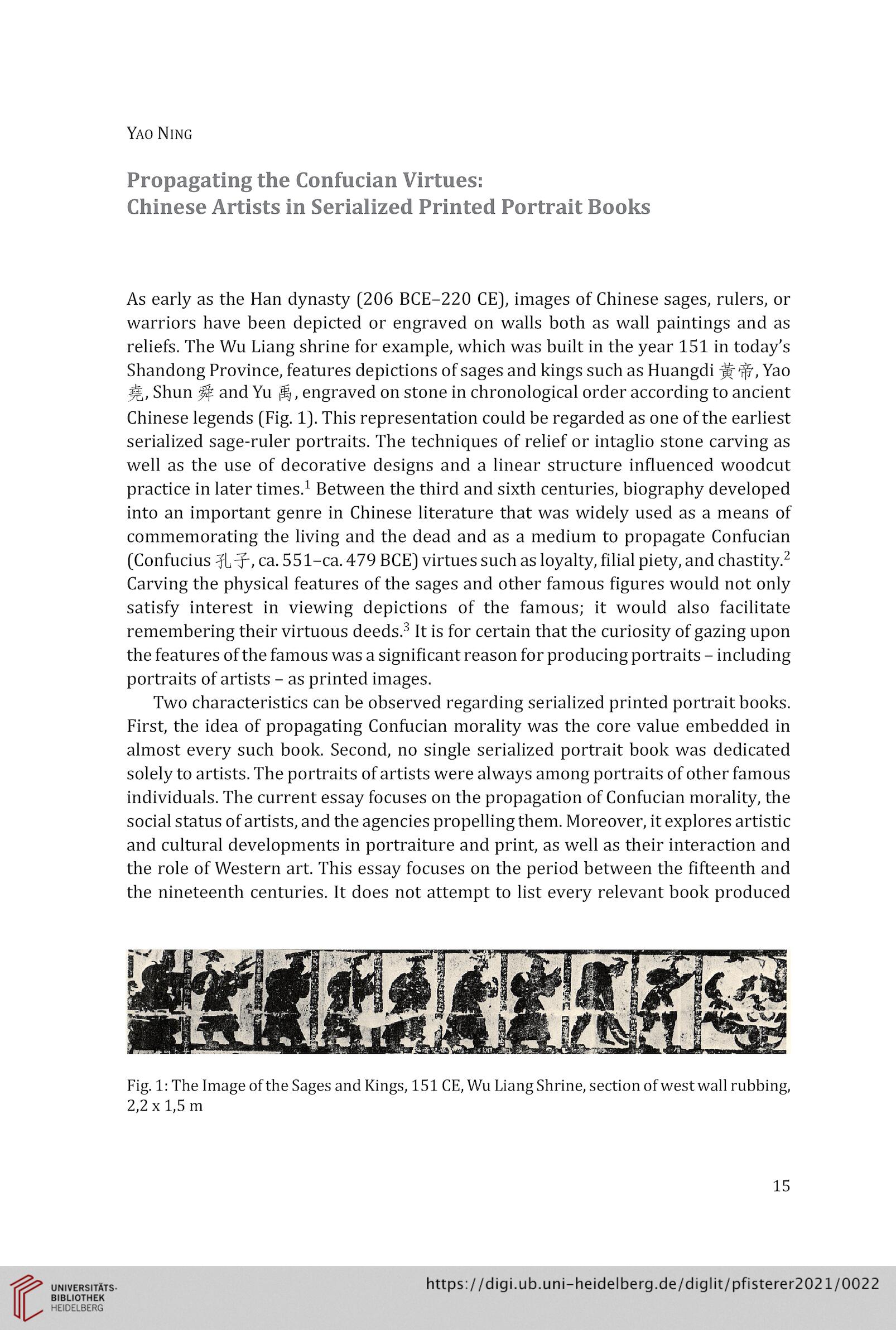Yao Ning
Propagating the Confucian Virtues:
Chinese Artists in Serialized Printed Portrait Books
As early as the Han dynasty (206 BCE-220 CE), images of Chinese sages, rulers, or
warriors have been depicted or engraved on walls both as wall paintings and as
reliefs. The Wu Liang shrine for example, which was built in the year 151 in today's
Shandong Province, features depictions of sages and kings such as Huangdi Yao
Shun and Yu , engraved on stone in chronological order according to ancient
Chinese legends (Fig. 1). This representation could be regarded as one of the earliest
serialized sage-ruler portraits. The techniques of relief or intaglio stone carving as
well as the use of decorative designs and a linear structure influenced woodcut
practice in later times.1 Between the third and sixth centuries, biography developed
into an important genre in Chinese literature that was widely used as a means of
commemorating the living and the dead and as a medium to propagate Confucian
(Confucius ca. 551-ca. 479 BCE) virtues such as loyalty, filial piety, and chastity.2
Carving the physical features of the sages and other famous figures would not only
satisfy interest in viewing depictions of the famous; it would also facilitate
remembering their virtuous deeds.3 It is for certain that the curiosity of gazing upon
the features of the famous was a significant reason for producing portraits - including
portraits of artists - as printed images.
Two characteristics can be observed regarding serialized printed portrait books.
First, the idea of propagating Confucian morality was the core value embedded in
almost every such book. Second, no single serialized portrait book was dedicated
solely to artists. The portraits of artists were always among portraits of other famous
individuals. The current essay focuses on the propagation of Confucian morality, the
social status of artists, and the agencies propelling them. Moreover, it explores artistic
and cultural developments in portraiture and print, as well as their interaction and
the role of Western art. This essay focuses on the period between the fifteenth and
the nineteenth centuries. It does not attempt to list every relevant book produced
Fig. l:The Image of the Sages and Kings, 151 CE, Wu Liang Shrine, section of west wall rubbing,
2,2 x 1,5 m
15
Propagating the Confucian Virtues:
Chinese Artists in Serialized Printed Portrait Books
As early as the Han dynasty (206 BCE-220 CE), images of Chinese sages, rulers, or
warriors have been depicted or engraved on walls both as wall paintings and as
reliefs. The Wu Liang shrine for example, which was built in the year 151 in today's
Shandong Province, features depictions of sages and kings such as Huangdi Yao
Shun and Yu , engraved on stone in chronological order according to ancient
Chinese legends (Fig. 1). This representation could be regarded as one of the earliest
serialized sage-ruler portraits. The techniques of relief or intaglio stone carving as
well as the use of decorative designs and a linear structure influenced woodcut
practice in later times.1 Between the third and sixth centuries, biography developed
into an important genre in Chinese literature that was widely used as a means of
commemorating the living and the dead and as a medium to propagate Confucian
(Confucius ca. 551-ca. 479 BCE) virtues such as loyalty, filial piety, and chastity.2
Carving the physical features of the sages and other famous figures would not only
satisfy interest in viewing depictions of the famous; it would also facilitate
remembering their virtuous deeds.3 It is for certain that the curiosity of gazing upon
the features of the famous was a significant reason for producing portraits - including
portraits of artists - as printed images.
Two characteristics can be observed regarding serialized printed portrait books.
First, the idea of propagating Confucian morality was the core value embedded in
almost every such book. Second, no single serialized portrait book was dedicated
solely to artists. The portraits of artists were always among portraits of other famous
individuals. The current essay focuses on the propagation of Confucian morality, the
social status of artists, and the agencies propelling them. Moreover, it explores artistic
and cultural developments in portraiture and print, as well as their interaction and
the role of Western art. This essay focuses on the period between the fifteenth and
the nineteenth centuries. It does not attempt to list every relevant book produced
Fig. l:The Image of the Sages and Kings, 151 CE, Wu Liang Shrine, section of west wall rubbing,
2,2 x 1,5 m
15




